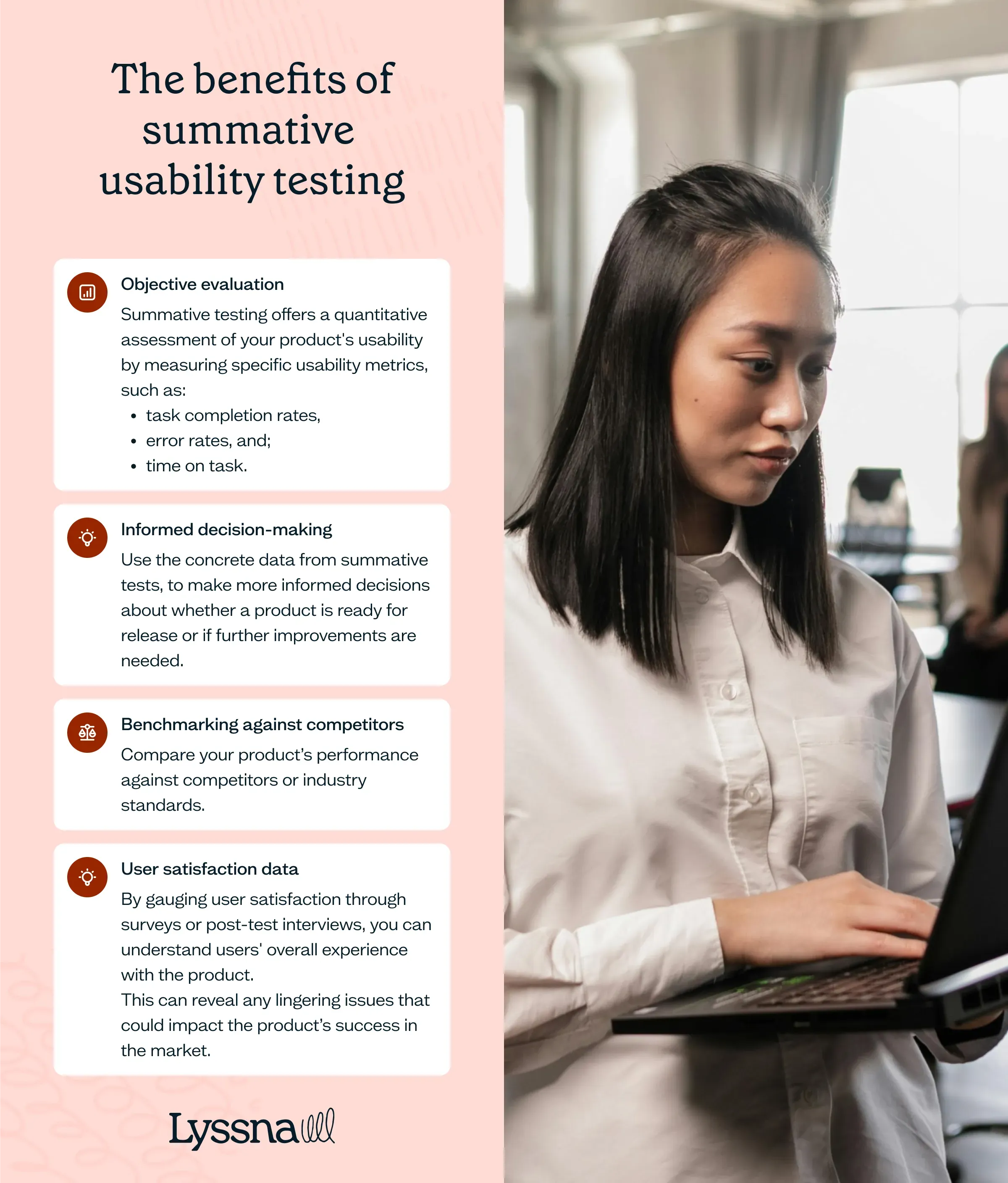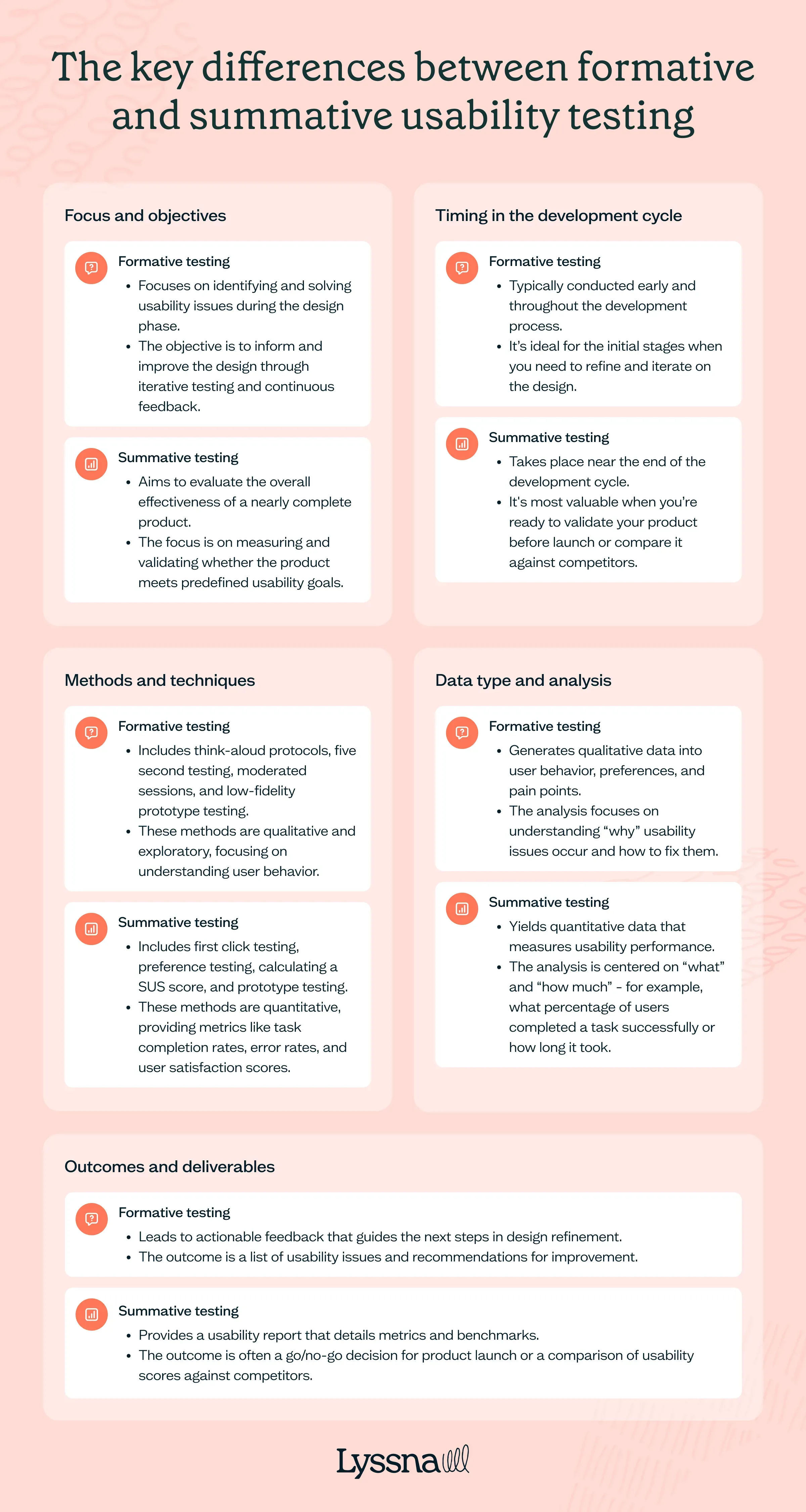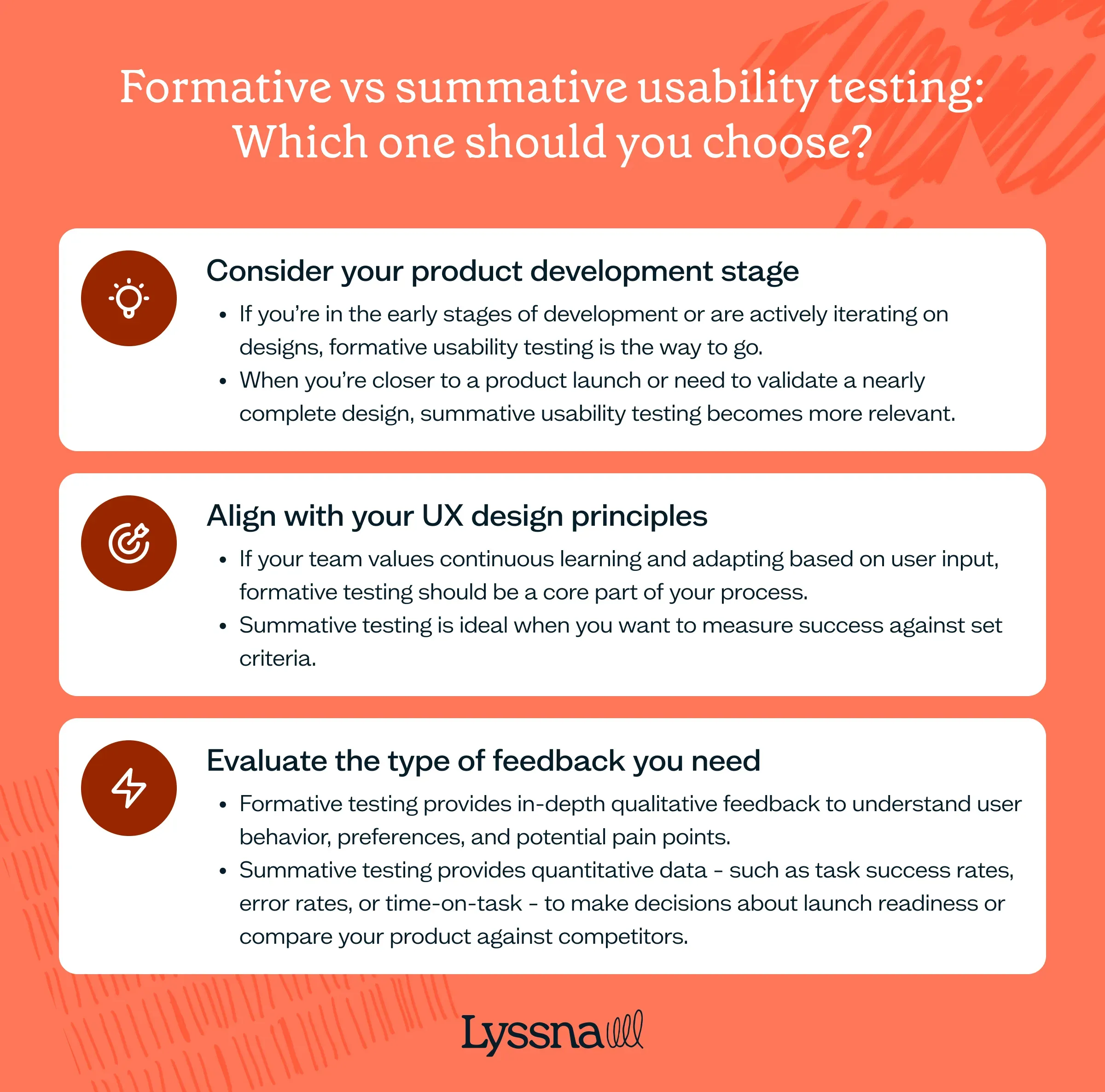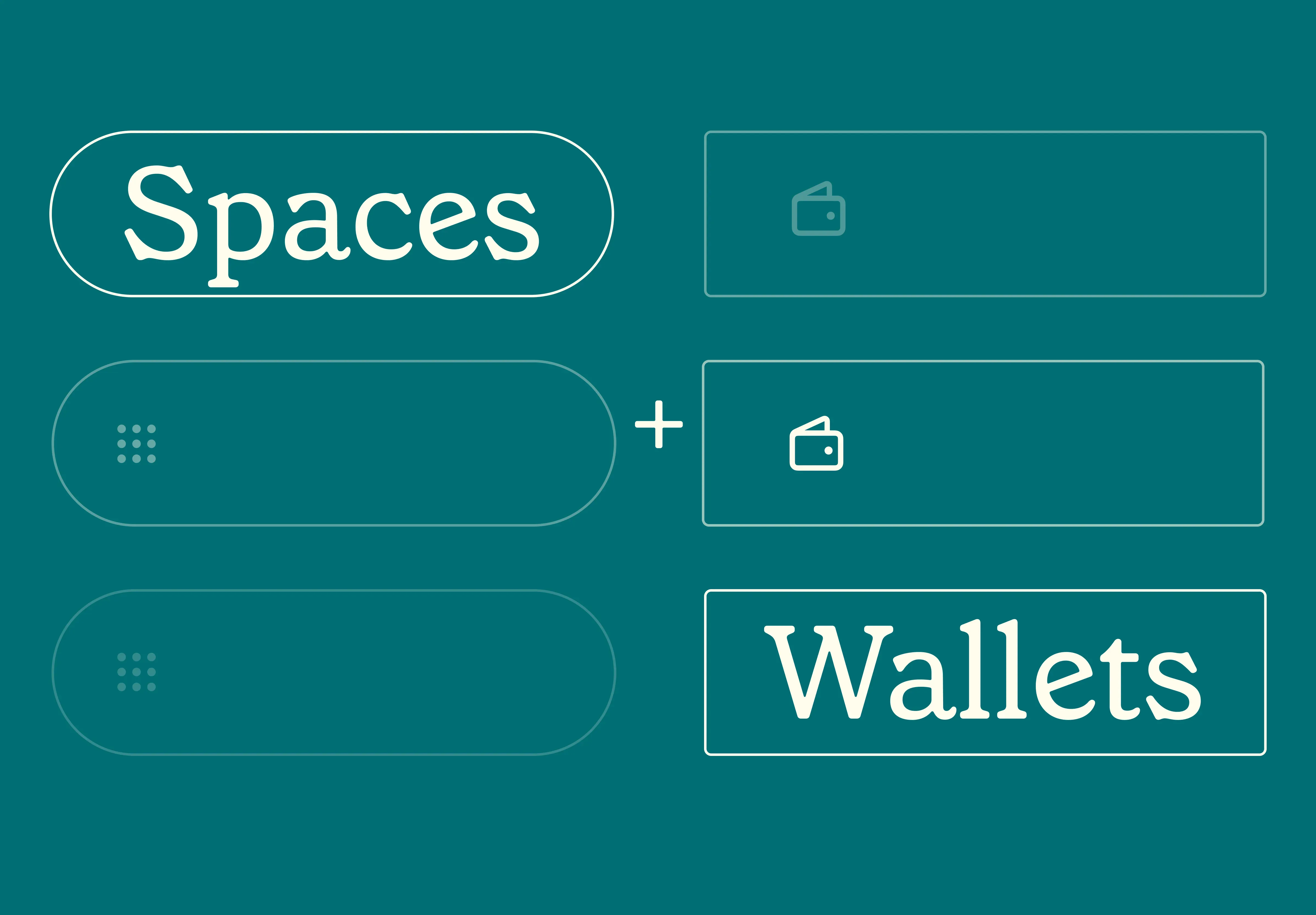14 Nov 2025
|13 min
Formative vs summative usability testing
Explore the differences between formative and summative usability testing: their purposes, when to use them, methods, and outcomes to enhance product design.

Usability testing is a critical component of UX research, helping teams make sure their designs are intuitive and user-friendly.
Within the world of usability testing, there are two primary approaches: formative and summative usability testing. Each serves a distinct purpose in the product development process, and understanding their differences is key to selecting the right approach for your needs.
This article explores these differences, looking at when and how you should use each method.
Key takeaways
Understanding the difference between formative and summative usability testing helps you choose the right method for your research goals.
Formative usability testing is an iterative process, focusing on identifying and solving usability problems during the development phase. It's ideal for gathering early feedback and refining your designs.
Summative usability testing evaluates the effectiveness of a design once it’s nearly complete. It aims to measure user satisfaction, task completion rates, and overall usability performance.
Both types of testing complement each other and provide value at different stages of the product development lifecycle.
What is formative usability testing?
Formative usability testing is all about shaping and refining your product during its development phase. It gives you the chance to catch and fix usability issues early, before they snowball into bigger problems. The primary goal is to understand the user’s experience in detail and make the necessary adjustments to improve it continuously.
Formative usability testing: Benefits
Formative usability testing brings several key benefits that can have a significant impact on product development:
Identify problems early: By conducting tests during the design phase, you can quickly identify and address usability problems, reducing the cost and effort needed for later changes.
Improve design iterations: The feedback from formative testing informs each iteration, so the product evolves in line with user needs and expectations.
Focus on users: This type of testing keeps the focus on the user. It makes sure the final product lines up with real user needs, not just assumptions or internal goals.
Collaborate and learn: Teams can collaborate closely during formative testing sessions, fostering a UX culture of learning and empathy for the user.

Formative usability testing: Methods
There are several methods you can use to conduct formative usability testing, depending on your goals and resources:
Think-aloud protocol: You ask participants to verbalize their thoughts while performing tasks and record their screen, audio, or video. This can be conducted in-person or remotely, and in a moderated or unmoderated format. This gives you a view of your users' thought processes and helps you identify usability issues.
Five second testing: This method involves showing users a screen or interface for five seconds and then asking them questions about what they remember or their initial impressions. It’s helpful during early stages of the design process to test visual clarity.
Moderated sessions: In these live sessions, you guide participants through tasks, ask follow-up questions, and probe deeper into usability issues. This approach, often referred to as moderated usability testing, is ideal for gaining more detailed findings.
Prototype testing: You can test specific elements or flows of your product using low- or medium-fidelity prototypes to gather actionable feedback.
Formative usability testing: Use cases
Formative usability testing is a versatile tool that can be applied across various stages of product development to uncover user feedback and guide design decisions.
It's particularly valuable in the early and middle stages of product development. Here are some common scenarios where it proves most useful:
Concept validation: When you have an early prototype or a wireframe, formative testing helps you test assumptions and validate the direction before committing more resources.
Design iteration: As you refine your product design, formative testing helps you make sure each iteration improves upon the last. Regular testing during these phases helps catch usability issues before they become ingrained in the design.
Exploring user behavior: When you want to dig deeper into how users interact with certain features, formative testing provides qualitative feedback that reveals users' thought processes, motivations, and pain points.
Run formative and summative tests with ease
Lyssna makes it simple to conduct both formative and summative usability tests, helping you refine early designs and validate your final product. Get started today!
What is summative usability testing?
Summative usability testing is used to assess a product's effectiveness and overall performance prior to launch. Unlike formative testing, which focuses on finding and fixing issues during development, summative testing measures key factors like user satisfaction, task success rates, and overall usability. This helps you work out if the product meets and addresses any usability issues.
Summative usability testing: Benefits
Summative usability testing can help validate your design decisions in a number of ways:
Objective evaluation: Summative testing offers a quantitative assessment of your product's usability by measuring specific usability metrics, such as task completion rates, error rates, and time on task. This helps you determine if your design meets its usability goals.
Informed decision-making: With concrete data from summative tests, you can make more informed decisions about whether a product is ready for release or if further improvements are needed.
Benchmarking against competitors: Summative testing allows you to compare your product’s performance against competitors or industry standards.
User satisfaction data: By gauging user satisfaction through surveys or post-test interviews, you can understand users' overall experience with the product. This can reveal any lingering issues that could impact the product’s success in the market.

Summative usability testing: Methods
There are several methods to conduct summative usability testing effectively, depending on your specific goals:
First click testing: Measure how quickly and accurately users complete a task based on their initial interaction. This helps you understand whether users can easily find the correct starting point when interacting with an interface.
Preference testing: Comparing designs helps you understand which one users favor and why. This can guide final decisions in product development (although you can also use this method during formative usability testing to help understand initial user preferences).
System usability scale (SUS): SUS provides a quick and simple way to gather user perceptions of usability. You can easily set up a survey using our template and calculate your SUS score.
Prototype testing: Prototype testing can be used during both formative and summative testing. In a summative context, you can test your high-fidelity prototypes to find out whether they meet usability standards before the final launch.
Summative usability testing: Use cases
Summative usability testing is most effective when you need to assess the overall performance and user satisfaction of a near-final product. It provides you with concrete data to make go/no-go decisions before a product launch or to compare your product’s performance against industry benchmarks.
Here are some scenarios where summative testing can provide the most value:
Pre-launch validation: Before launching your product, summative testing can help you make sure it meets all usability standards and user expectations, addressing them before your product goes to market.
Assessing the effectiveness of redesigns: If you’ve recently redesigned a feature or interface, summative testing allows you to compare the new version against the old one, especially when redesigning a product to enhance usability.
Measuring usability against competitors: Summative testing can be used to evaluate how your product performs relative to competitor products, and conducting a thorough ux competitor analysis can provide valuable context for interpreting these results.
Benchmarking usability improvements: If you’ve made incremental changes to your product over time, summative testing helps you measure the cumulative impact of these changes. Basically, making sure the usability is going in the right direction!
Formative vs summative usability testing: Key differences
Both formative and summative usability testing are key to a strong UX research strategy. Each has its own role to play at different stages of product development. By getting to know their differences, you can confidently choose the method that best fits your needs.

Focus and objectives
Formative usability testing: Focuses on identifying and solving usability issues during the design phase. The objective is to inform and improve the design through iterative testing and continuous feedback.
Summative usability testing: Aims to evaluate the overall effectiveness of a nearly complete product. The focus is on measuring and validating whether the product meets predefined usability goals.
Timing in the development cycle
Formative testing: Typically conducted early and throughout the development process. It’s ideal for the initial stages when you need to refine and iterate on the design.
Summative testing: Takes place near the end of the development cycle. It's most valuable when you’re ready to validate your product before launch or compare it against competitors.
Methods and techniques
Formative methods: Includes think-aloud protocols, five second testing, moderated sessions, and low-fidelity prototype testing. These methods are more qualitative and exploratory, focusing on understanding user behavior.
Summative methods: Includes first click testing, preference testing, calculating a SUS score, and prototype testing. These methods are more quantitative, providing metrics like task completion rates, error rates, and user satisfaction scores.
Data type and analysis
Formative testing: Generates qualitative data that provides valuable feedback into user behavior, preferences, and pain points. The analysis focuses on understanding “why” usability issues occur and how to fix them.
Summative testing: Yields quantitative data that measures usability performance. The analysis is centered on “what” and “how much” – for example, what percentage of users completed a task successfully or how long it took. These kinds of metrics are common in various types of quantitative research, which summative usability testing often draws from to provide measurable insights.
Outcomes and deliverables
Formative testing: Leads to actionable feedback that guides the next steps in design refinement. The outcome is a list of usability issues and recommendations for improvement.
Summative testing: Provides a usability report that details metrics and benchmarks. The outcome is often a go/no-go decision for product launch or a comparison of usability scores against competitors.
Knowing these key differences will help you choose the usability testing method that best suits your product’s stage and goals.
Formative vs summative usability testing: Which one should you choose?
Choosing between formative and summative usability testing really comes down to where you are in the product development process and what your goals are. Both methods have their own benefits, and often, they work best together to build a solid, well-rounded strategy.

Consider your product development stage
If you’re in the early stages of development or are actively iterating on designs, formative usability testing is the way to go. It helps you uncover usability issues, refine features, and ensure each iteration moves closer to what users need.
When you’re closer to a product launch or need to validate a nearly complete design, summative usability testing becomes more relevant. It provides a clear, data-driven picture of whether the product meets usability standards and user expectations.
Align with your UX design principles
Formative testing aligns well with UX design principles that emphasize user feedback and iterative design. If your team values continuous learning and adapting based on user input, formative testing should be a core part of your process.
Summative testing, on the other hand, is ideal when you want to measure success against set criteria. It supports design principles that require clear benchmarks and performance metrics to validate the final product.
Evaluate the type of feedback you need
If you’re looking for in-depth qualitative feedback to understand user behavior, preferences, and potential pain points, formative testing offers the flexibility to explore these areas in detail.
When you need quantitative data – such as task success rates, error rates, or time-on-task – to make decisions about launch readiness or compare your product against competitors, summative testing is more appropriate.
Consider a collaborative UX design approach
For a collaborative UX design process where you work closely with stakeholders, designers, and developers, both formative and summative usability testing can play crucial roles. Start with formative testing to guide early design decisions, and then use summative testing to validate the final product.
By carefully considering these factors – your development stage, UX design principles, the type of feedback you need, and your collaborative approach – you can choose the usability testing method that best supports your goals. Often, the most effective strategy is to combine both formative and summative testing throughout the product life cycle for a comprehensive, user-centric approach.
Ready to test? Explore our template library
If you're looking for a quick start to formative and summative usability testing, our templates can help you set up your tests faster. Browse through our collection and customize a template to suit your needs.
You may also like these articles


Try for free today
Join over 320,000+ marketers, designers, researchers, and product leaders who use Lyssna to make data-driven decisions.
No credit card required






